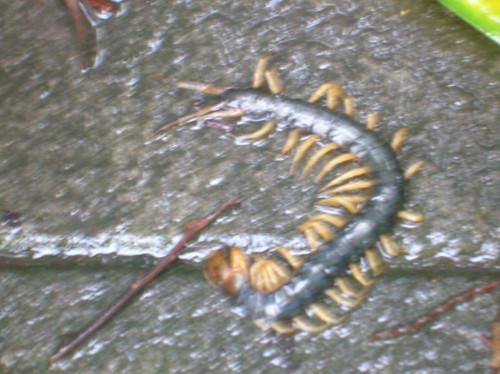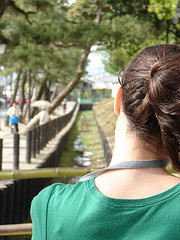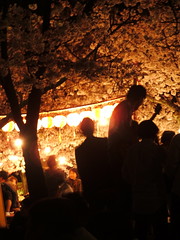We started our first day in Nagasaki by taking the bus up to Mt. Inasa. We were assured, when we shelled out the thousands of dollars for this trip, that the view of Nagasaki from Inasa was one of the most breath-taking in Japan. We will just have to take their word for it.
The kids enjoyed a touristy photo op before we hopped on the cable car.
The photo came out well despite the fact that Ryan is approximately twice the height of this particular attraction's target demographic.
We got a fleeting glimpse of the city as the cable car took us deeper and deeper into the mist. By the time we reached the lookout on the top of the mountain, we were surprised to see that the view from Mt. Inasa looked shockingly like the view of Mt. Aso we had had a few days before.
The most thrilling part of our visit to Mt. Inasa actually came as we were hiking back down from the summit to the cable car and RJ spotted the one thing he really came to Japan to see: a dreaded mukade. Now, what you have to keep in mind is that at this point, I had literally been telling mukade stories to some of these kids for three years, so they were basically prepared for the thing to leap up at them, its jaws slung with bloody slather and eyes lit by the fires of Hades' own eternal damned kingdom.
Fortunately, as you can see from the photo (courtesy of RJ), it was not only a rather small mukade but also a decidedly dead one. Whew! Dodged a bullet there!
On our first full day in Nagasaki, we went to the atomic bomb memorial. Unlike the Hiroshima museum, which is a large building in the middle of a wide open space leveled by the bomb, the Nagasaki A-Bomb Museum is built underground. While it contains many of the same type of photographs, mementos, and exhibits that we saw at the Hiroshima museum, the difference in atmosphere between the two was incredible.
While the Hiroshima museum had been silent and virtually empty, the Nagasaki museum and the surrounding gardens were over-flowing with Japanese students of all ages. Inside the museum, many of them were on scavenger hunts, racing from exhibit to exhibit trying to find the information they needed for their assignments. Outside, older students were there with their Peace Studies classes, stopping museum visitors and having them fill out surveys about their reactions to the museum and their thoughts about the atomic bomb specifically and war in general. They were nervous and giggly about using their English to talk to us, but they were also wonderfully friendly and welcoming and I had a great time talking with them and making them laugh with my rubbish Japanese.

Though the outdoor memorial featured plenty of origami cranes and centered on a beautiful pool just as the Hiroshima memorial had, the atmosphere was lively and refreshing, and Nagasaki Peace Park, which includes statues about peace from artists all over the world, is much more extensive than the memorial park in Hiroshima.

Peace Statue, which is the focal point of Nagasaki Peace Park sits on top of an infinity pool. His right hand points up as a reminder of the bomb, but his left hand is extended as a symbol of peace.
A Japanese student plays with the water at the edge of the infinity pool
Peace Statue reflected in the infinity pool -- While the Hiroshima memorial is centered on the idea of remembering the tragedy of the atomic bombing, the Nagasaki memorial is focused on the notion of healing and of promoting peace around the world.
All this happened, more or less...
My name is G and these are the true stories of my adventures.
Monday, July 27, 2009
Mt. Inasa and the Nagasaki A-Bomb Memorial
by
G
at
4:04 PM
![]()
Labels: a-bomb memorial, famous places, japan, Nagasaki, peace, places to go
Subscribe to:
Post Comments (Atom)





 Stumble It!
Stumble It!






No comments:
Post a Comment